
Students analyze the distribution of categorical data. They calculate percents and visually compare the data sets with a bar chart.
- Subject:
- Mathematics
- Material Type:
- Lesson Plan
- Provider:
- Texas Instruments
- Date Added:
- 08/07/2023

Students analyze the distribution of categorical data. They calculate percents and visually compare the data sets with a bar chart.

Students quantify the percent of light reflected from solutions containing varying concentrations of red dye using LEGO© MINDSTORMS© NXT bricks and light sensors. They begin by analyzing a set of standard solutions with known concentrations of food coloring, and plot data to graphically determine the relationship between percent reflected light and dye concentration. Then they identify dye concentrations for two unknown solution samples based on how much light they reflect. Students gain an understanding of light scattering applications and how to determine properties of unknown samples based on a set of standard samples.

The digital slideshow provides students with the opportunity to observe and use evidence from their observations to predict and record how the Moon appears to follow a regular pattern of change over time. Teaching tips and background reading is provided.
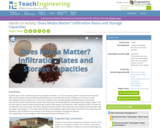
Students gain a basic understanding of the properties of media soil, sand, compost, gravel and how these materials affect the movement of water (infiltration/percolation) into and below the surface of the ground. They learn about permeability, porosity, particle size, surface area, capillary action, storage capacity and field capacity, and how the characteristics of the materials that compose the media layer ultimately affect the recharging of groundwater tables. They test each type of material, determining storage capacity, field capacity and infiltration rates, seeing the effect of media size on infiltration rate and storage. Then teams apply the testing results to the design their own material mixes that best meet the design requirements. To conclude, they talk about how engineers apply what students learned in the activity about the infiltration rates of different soil materials to the design of stormwater management systems.

This game helps students to understand the concepts of changing supply, changing demand, and equilibrium price, as the price of bags of ice changes after a hurricane has swept through a community.
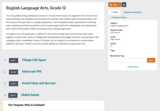
The 12th grade learning experience consists of 7 mostly month-long units aligned to the Common Core State Standards, with available course material for teachers and students easily accessible online. Over the course of the year there is a steady progression in text complexity levels, sophistication of writing tasks, speaking and listening activities, and increased opportunities for independent and collaborative work. Rubrics and student models accompany many writing assignments.Throughout the 12th grade year, in addition to the Common Read texts that the whole class reads together, students each select an Independent Reading book and engage with peers in group Book Talks. Language study is embedded in every 12th grade unit as students use annotation to closely review aspects of each text. Teacher resources provide additional materials to support each unit.

This project unit—a multimedia self-portrait published in digital form—is the capstone of your students' high school careers. It is a chance for them to pause and reflect on where they've been, where they're going, and who they are as a person. Students will reflect on what they want others to know about them: what they want their message to be and what types of media they might use to convey that message. Students will have the opportunity to express themselves in many different formats—through writing, of course, but also through other media of their choosing. Students will be able to convey your message through visual art, photography, a graphic novel, audio, poetry, or video—practically any type of media they want!
ACCOMPLISHMENTS
Students will complete a multimedia self-portrait, capturing important aspects of the essence of themselves.
Students will contribute one chapter from their multimedia self-portrait to a class anthology.
Students will present one chapter from their multimedia self-portrait to the class.
GUIDING QUESTIONS
These questions are a guide to stimulate thinking, discussion, and writing on the themes and ideas in the unit. For complete and thoughtful answers and for meaningful discussions, students must use evidence based on careful reading of the texts.
How is late adolescence a moment of internal and external change?
What are the most important qualities of your character—past, present, and future?
How can you portray these key aspects of yourself using multimedia?
BENCHMARK ASSESSMENT: Cold Read
During this unit, on a day of your choosing, we recommend you administer a Cold Read to assess students’ reading comprehension. For this assessment, students read a text they have never seen before and then respond to multiple-choice and constructed-response questions. The assessment is not included in this course materials.

What are your students’ strongest personal character strengths at this point in their lives? As students mine the interviews they conducted, they’ll look for character strengths others see in them. Do they see these strengths in themselves? Are they qualities that your students want to portray in their self-portrait?

In our lives, we are constantly telling stories to ourselves and to others in an attempt to both understand our experiences and present our best selves to others. But how do we tell a story about ourselves that is both true and positive? How do we hold ourselves up in the best possible light, while still being honest about our struggles and our flaws? Students will explore ways of interpreting and portraying personal experiences. They'll read Chinua Achebe's novel Things Fall Apart , analyzing the text through the eyes of one character. They'll get to know that character's flaws and strengths, and they'll tell part of the story from that character's perspective, doing their best to tell an honest tale that presents their character's best side. Then they'll explore their own stories, crafting a personal narrative about an important moment of learning in his or her life.
ACCOMPLISHMENTS
Students read and analyze Chinua Achebe’s Things Fall Apart , viewing the events and conflicts of the novel through the eyes of one of the central characters.
Students write a two-part narrative project: one narrative told through their character’s perspective and one personal narrative about an incident in their own life.
GUIDING QUESTIONS
These questions are a guide to stimulate thinking, discussion, and writing on the themes and ideas in the unit. For complete and thoughtful answers and for meaningful discussions, students must use evidence based on careful reading of the texts.
How do our conflicts shape and show our character?
How can we tell a story about ourselves that’s both honest and positive?
How do definitions of justice change depending on the culture you live in?
What are ways individuals can react to a changing world? To a community that doesn’t accept us?
BENCHMARK ASSESSMENT: Cold Read
During this unit, on a day of your choosing, we recommend you administer a Cold Read to assess students’ reading comprehension. For this assessment, students read a text they have never seen before and then respond to multiple-choice and constructed-response questions. The assessment is not included in this course materials.
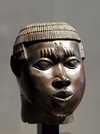
In this lesson, students will work to finish the revision of their personal narrative.

A very detailed biography of Erwin Schrodinger. Including links and cross references to historical topics.

Explore plant and animal cells with this interactive site. Explanations are provided for each cell organelle.

This interactive game is similar to Concentration. Students must evaluate the expression in the puzzle for the given value and match it with the correct answer.

The resources, tips, and professional development opportunities shared throughout this digital notebook are rooted in skills supporting critical media literacy. Media literacy education emphasizes skills of inquiry and expression and empowers students to think critically, communicate effectively, and engage as active citizens. We hope these media-rich resources, lesson plans, worksheets, and question stem cards inspire you to engage your students with media analysis and media making in new ways. A full printable PDF of the digital notebook is available under support materials.
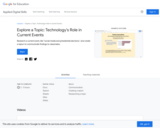
Research a current event, like “social media and presidential elections,” and create a report to communicate findings to classmates. Time to complete: 2-5 hours

What does media balance mean for me? Helping kids learn what makes different media choices healthy or not is a good start. But how do we help them actually make responsible choices in the real world? Give your students the opportunity to create a personalized media plan. Approximately 45 mins.
LESSON OBJECTIVES: Reflect on how balanced they are in their daily lives. Consider what "media balance" means, and how it applies to them. Create a personalized plan for healthy and balanced media use.

This video details a formula for making political art in five easy steps by offering examples of successful projects from high profile artists Banksy, Corita Kent, Emory Douglas, Ai Wei Wei, Shepard Fairey and Barbara Kruger. [3 min, 23 sec]
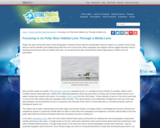
This article presents an overview of news and information presentations around the issue of polar bears drowning at sea due to melting polar ice, and how students might hone their news and information analysis skills taking into account media bias.
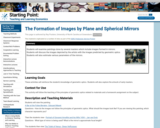
The formation of images by plane and spherical mirrors will be studied by examining paintings done by several masters which include images formed in mirrors.

Explore the intersection between media and politics. Through a study of foundational documents like the Constitution, specifically the 1st Amendment, students learn about the evolution of media, the impact of political ads on policy, bias in the media, and the effects of media framing, priming, and agenda setting in the shaping of American government and politics. [11:59]